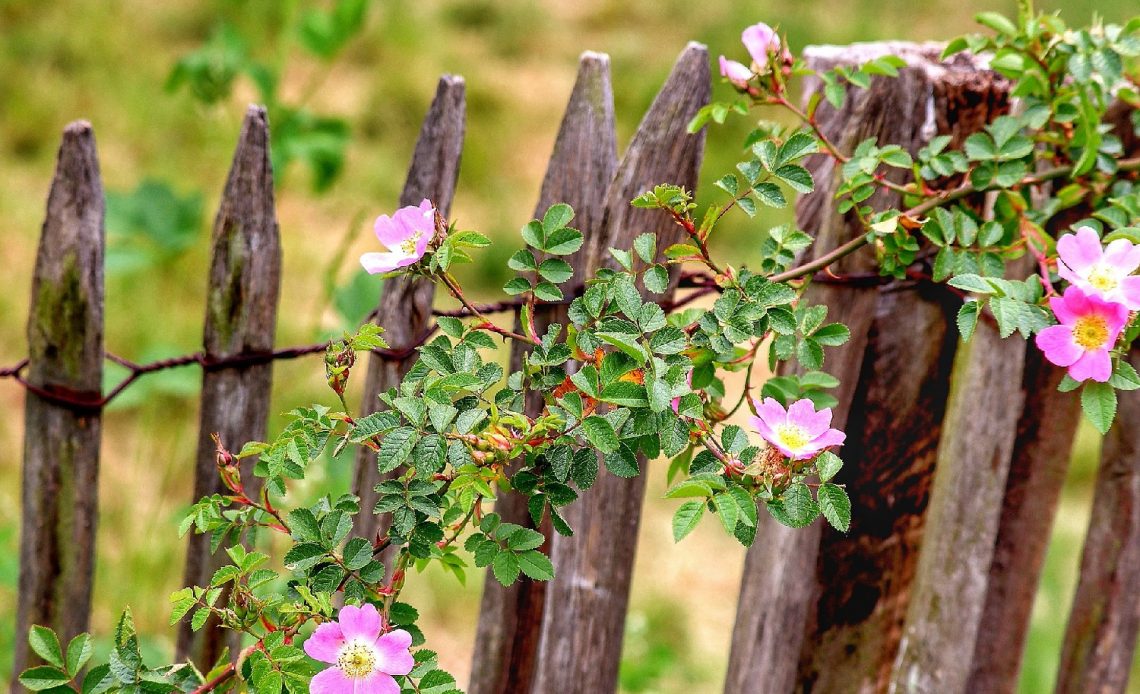

We’re here to help! Wild Yards is a completely free website that is 100% dedicated to helping you create a wildlife-friendly, sustainable yard. Read more
WildYards is reader-supported. When you buy a product through a link on our site, we may earn a comission. Every product is independently selected by our (obsessive) editors and our reviews are unbiased and objective. Read more about our mission or our privacy policy.
They say fences make good neighbors, but they’re also an excellent opportunity for backyard gardeners to grow something beautiful. If you’ve got a chain link fence along the perimeter of your property, using it as a trellis for climbing plants is a great way to spruce things up. You can also use these vines to decorate run-down sections of wooden fences, turning them into gorgeous focal points. Either way, these fast-growing climbing plants for fences are just what you need to give your yard a makeover.
Flowering climbing plants like Bougainvillea, Wisteria, and Passionflower add a quick burst of color to your fence line. Climbing Hydrangeas and Climbing Roses are perfect choices for yards that are situated in partial shade, while Passion Fruit Vine, Star Jasmine, and Morning Glory grow well in sunnier locations.
13 Fast-Growing Climbing Plants for Your Fences
Whether your yard is situated in a shady spot in the woods or right out in the open sunshine, there’s a climbing plant to suit your needs. But if you’re not careful to keep these vines in check, they may overtake surrounding plants. So before you plant these 13 fast-growing climbing plants for fences, make sure you’ve got a sharp pair of clippers in your shed, and be prepared to break them out regularly.
Trumpet Vine (zones 4 through 9)
Native to North America, Trumpet Vine grows best in sandy loam soil that is moist, but well-drained. You’ll often spot this plant growing wild in woodland and lowland areas, where it can receive full to partial sunlight. Trumpet Vine grows incredibly fast and tops out at around 40 feet.
Trumpet Vine thrives in hot, humid environments. It can still grow in cooler, drier places, but it won’t grow as quickly. Trumpet Vine comes in several gorgeous varieties, including ‘Flava’, which produces golden flowers, and ‘Atropurpurea’, which has bright red blooms. Trumpet Vine is a big hit with pollinators, especially hummingbirds and butterflies. Self-sufficient and adaptable, Trumpet Vine will produce dozens of flowers season after season, and you don’t even have to fertilize it.
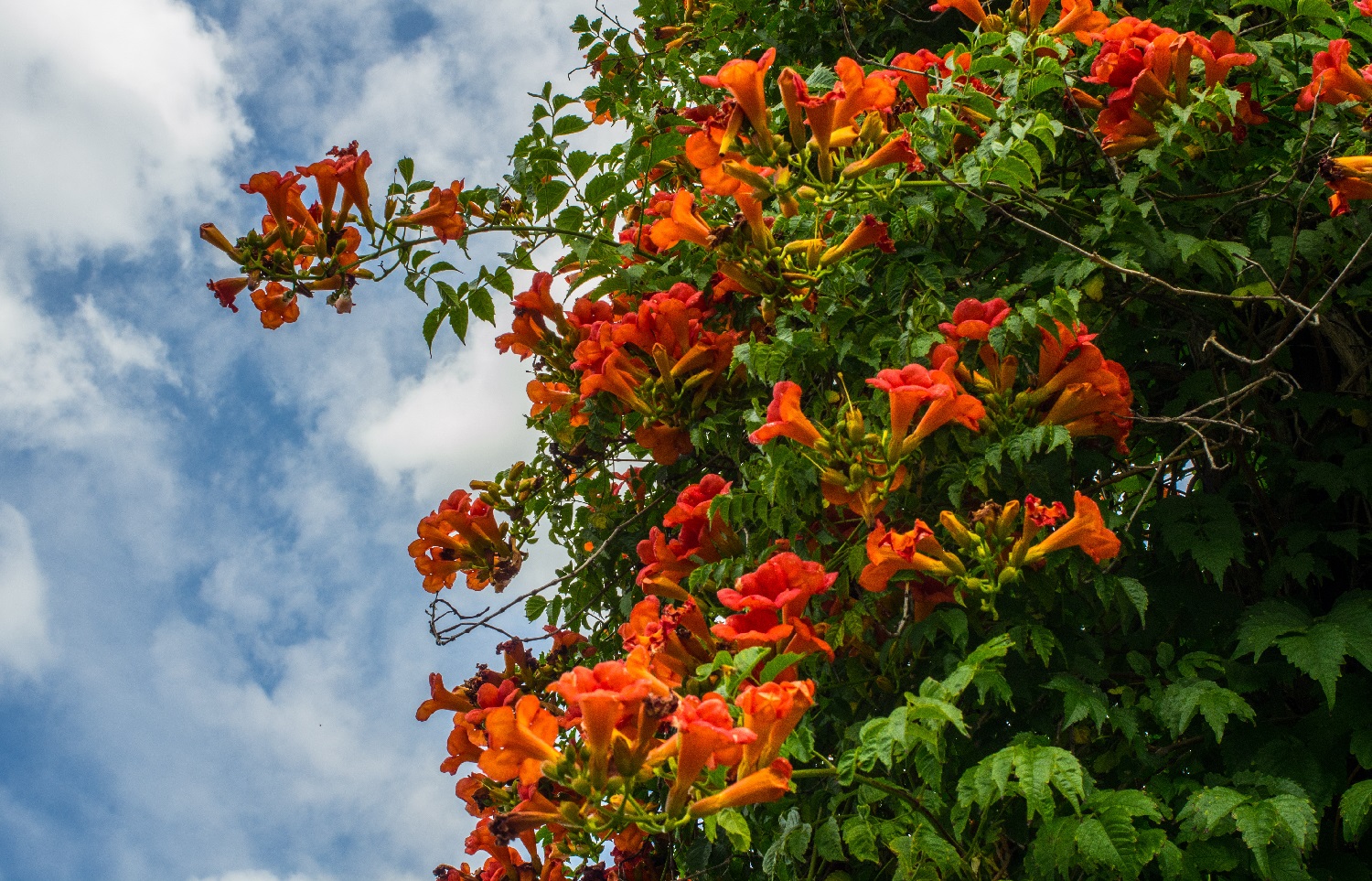
Climbing Hydrangeas (zones 5 through 9)
Slow to start, but quick to grow once well-established, Climbing Hydrangeas produce lovely white flowers that bees, butterflies, and hummingbirds love to visit. This plant grows best in partial shade, ideally in a location where it can receive morning sun and afternoon shade. This particular variety of hydrangea isn’t too picky about what kind of soil you plant it in. Just be sure it’s moist but well-draining.
Climbing Hydrangeas can grow up to 50 feet tall, so they’re not just well-suited to growing along fences. They can be used to climb up the sides of houses, garages, and other structures, too. Because Climbing Hydrangeas are deciduous, they’re an excellent choice for anyone who wants to block out the sun in the summer, but allow more light in during the winter.
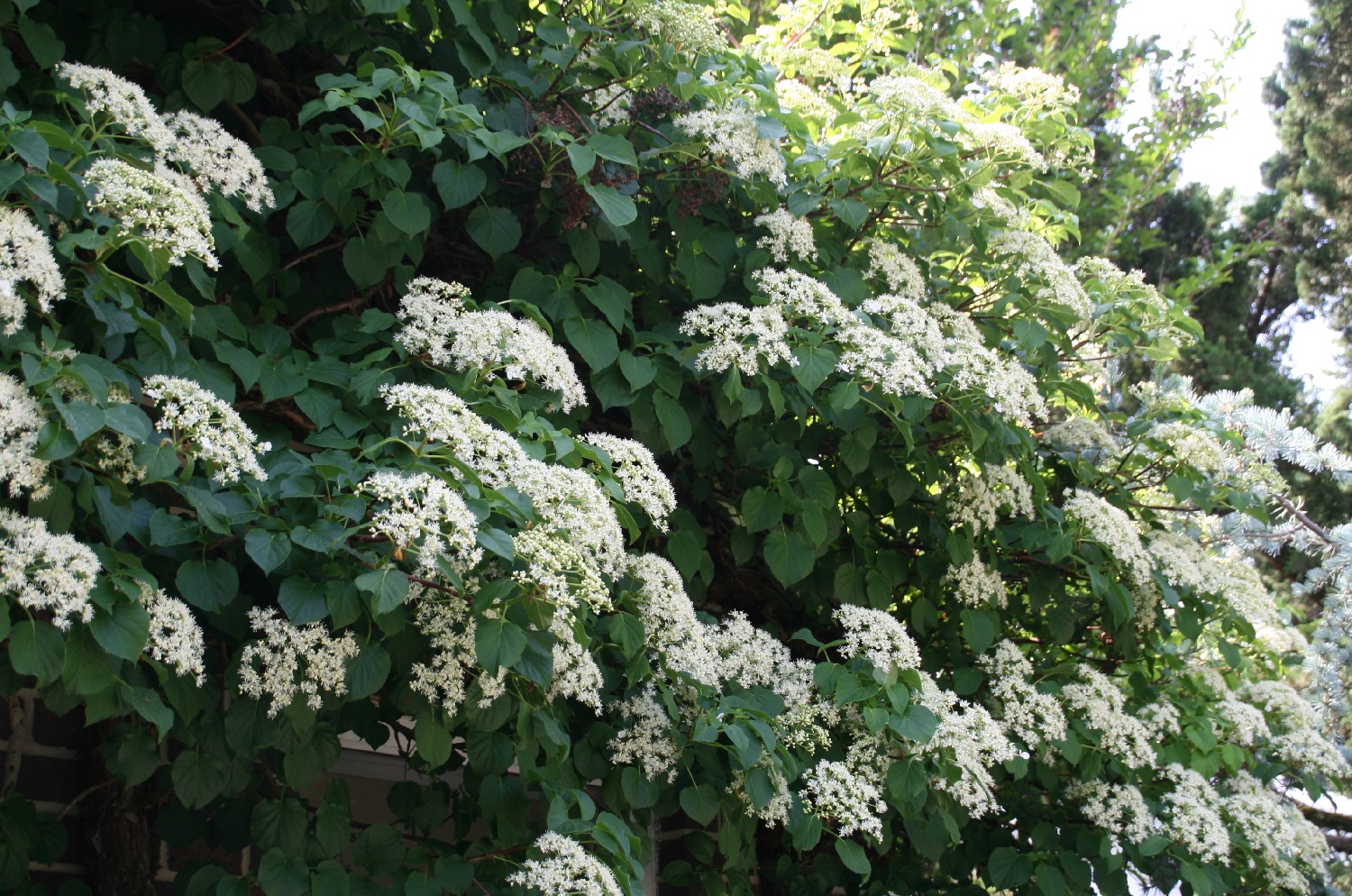
Honeysuckle (zones 4 through 9)
If you want to dress up your fences and attract more wildlife to your yard, you can’t go wrong with Honeysuckle. Whether you choose flashy pink and orange ‘Peaches & Cream’ or bright red ‘Coral’ Honeysuckle, these flowers are popular with hummingbirds and bees. And in fall, Honeysuckle produces small berries that birds and squirrels like to eat.
Honeysuckle grows best in full to partial sunlight, and it prefers well-drained, moist soil. Over time, Honeysuckle can develop a shrub-like appearance. But if you train it to grow along a fence, its branches will cascade over the rails and all around it, eventually covering the structure entirely. This plant is considered by many to be invasive, so if you want a climbing plant to accent your fence, not smother it, be sure to trim your Honeysuckle back regularly.
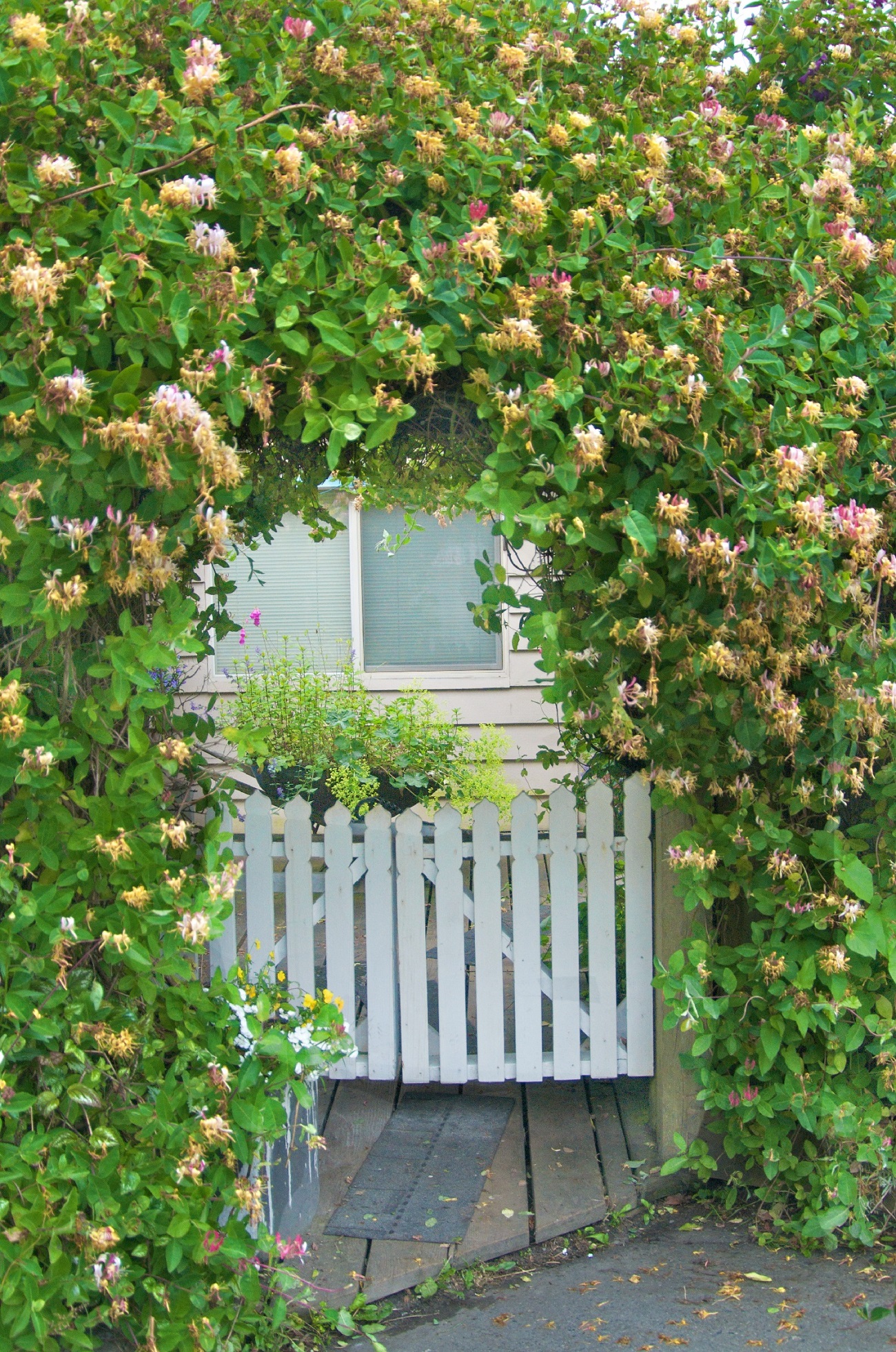
Clematis (zones 3 through 9)
Moderate to fast-growing, Clematis loves the light, making it a great option for anyone whose yard gets full to partial sun. There are over 300 species of Clematis to choose from, including the ‘Armandii Snowdrift’ with its delicate clusters of white flowers, and ‘Jackmanii’ with its blue and purple four-petal blooms.
Clematis is famous for its bright, fragrant blooms. Growing this climber along your fenceline will attract bees, butterflies, and hummingbirds throughout the spring and summer months. Some varieties of Clematis, such as ‘Sweet Autumn’, even bloom in fall. Whichever Clematis you choose, be sure to plant it in loose, alkaline soil that contains a good mixture of clay, sand, and organic matter.
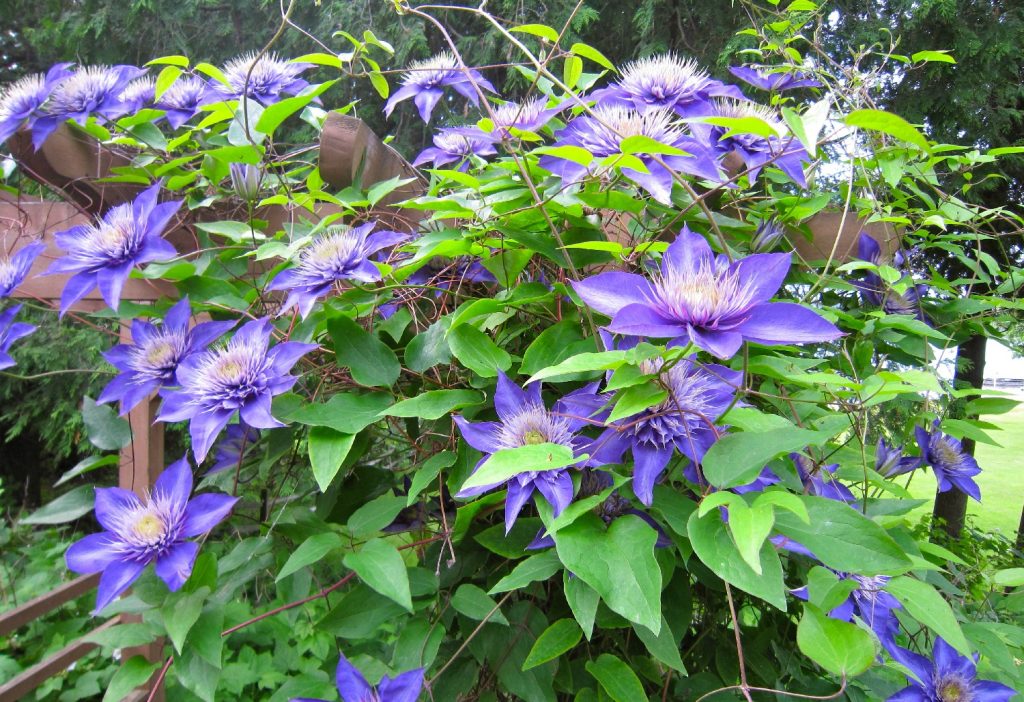
Hyacinth Bean Vine (zones 10 through 11)
Did you know that legumes improve nitrogen availability in the soil? Growing Hyacinth Bean Vine along your fence doesn’t just dress up an eyesore. It also improves nutrient availability to surrounding plants. The Hyacinth Bean Vine certainly earns its keep!
This vine doesn’t require much attention. All you have to do is meet its basic requirements, and it can handle the rest. Grow your Hyacinth Bean Vine in full sun in soil that drains well, and be sure to water it regularly. Keeping your Hyacinth Bean Vine well-hydrated, without allowing the soil to become muddy, encourages growth in the early summer months, so the plant will quickly reach its maximum height of 15 feet. Hyacinth Bean Vine blooms from early summer to early winter and comes back on its own, so you can keep enjoying it year after year.
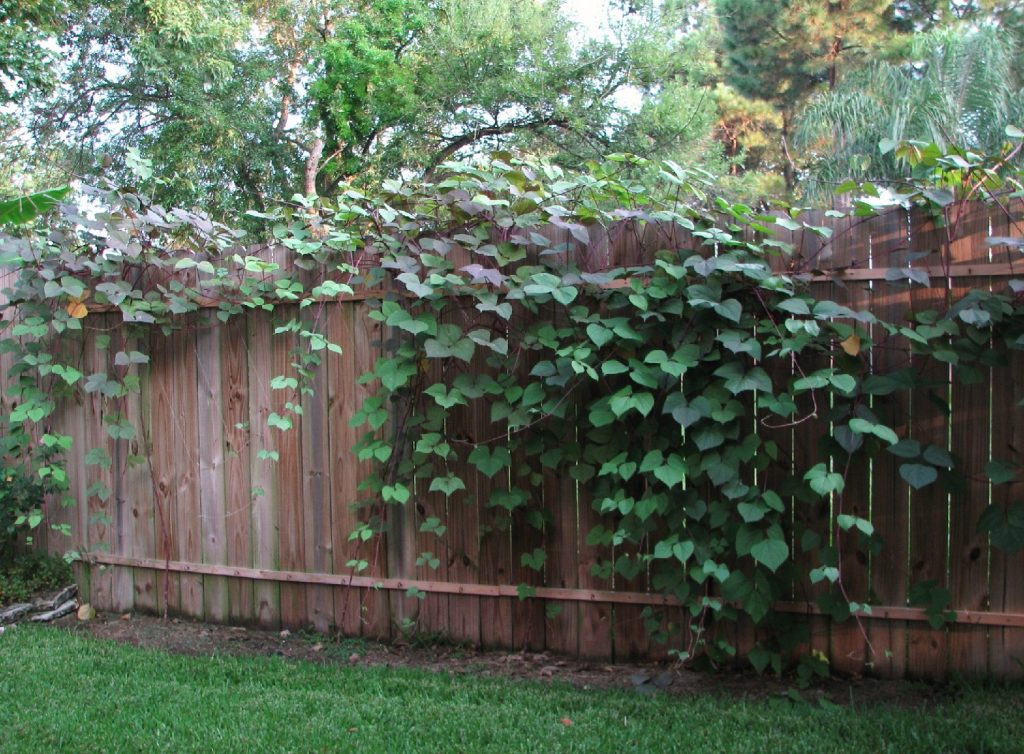
Wisteria (zones 5 through 9)
Traditional Purple Wisteria is a popular choice for gardeners everywhere, regardless of skill level. It grows easily in full to partial sun when planted in fertile, well-drained soil. Wisteria is a favorite with bees, hummingbirds, and butterflies with flowers growing up to 12 inches long. This fragrant climbing plant grows fairly quickly, steadily turning your rundown fences into enchanting focal points.
‘Blue Moon’ Wisteria is a lovely cultivar with blue-purple flowers blooming in spring and again in summer. And ‘Amethyst Falls’ Wisteria features pretty blossoms in shades of lavender, periwinkle, and lilac. These plants are deer-resistant, pest-resistant, and disease-resistant. Mix and match Wisteria varieties for a variegated appearance.
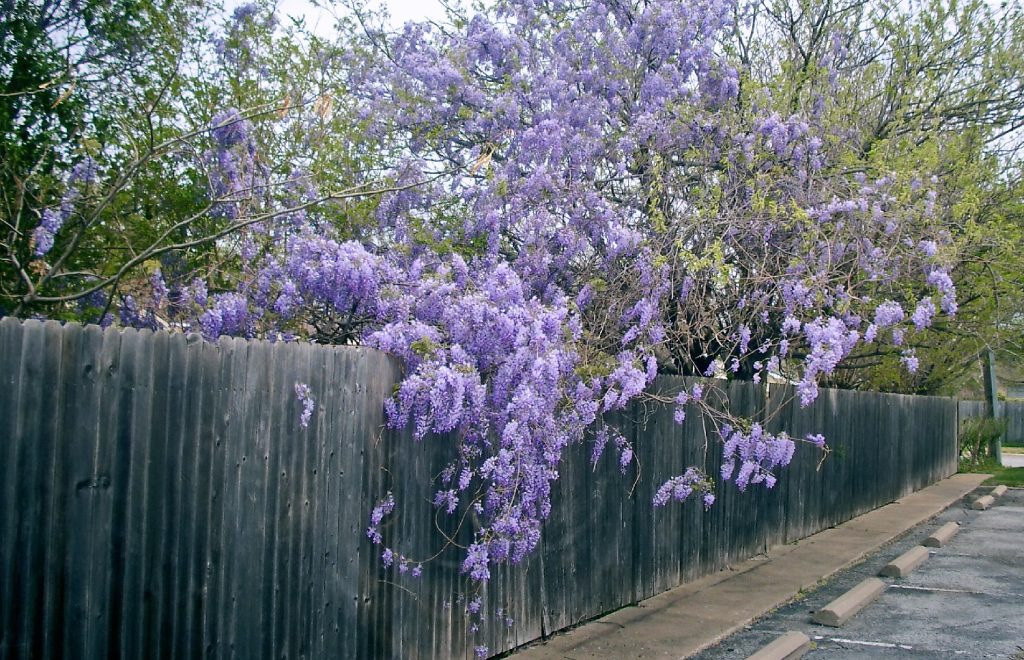
English Ivy (zones 3 through 8)
English Ivy’s deep green foliage provides a touch of class to any fenceline. This plant grows best in full sun in cooler climates and partial shade in hotter regions. High humidity is key to maintaining this vine’s lush foliage, and regular waterings allow it to quickly reach its maximum height of 30 feet.
English Ivy produces small clusters of white flowers in the fall when it attracts beetles, bees, and other helpful pollinators. The flowers are followed by small purple berries that birds love to eat. Grow your English Ivy along ugly fences that you want to hide. It will smother them fast and may cover the ground around them, too.
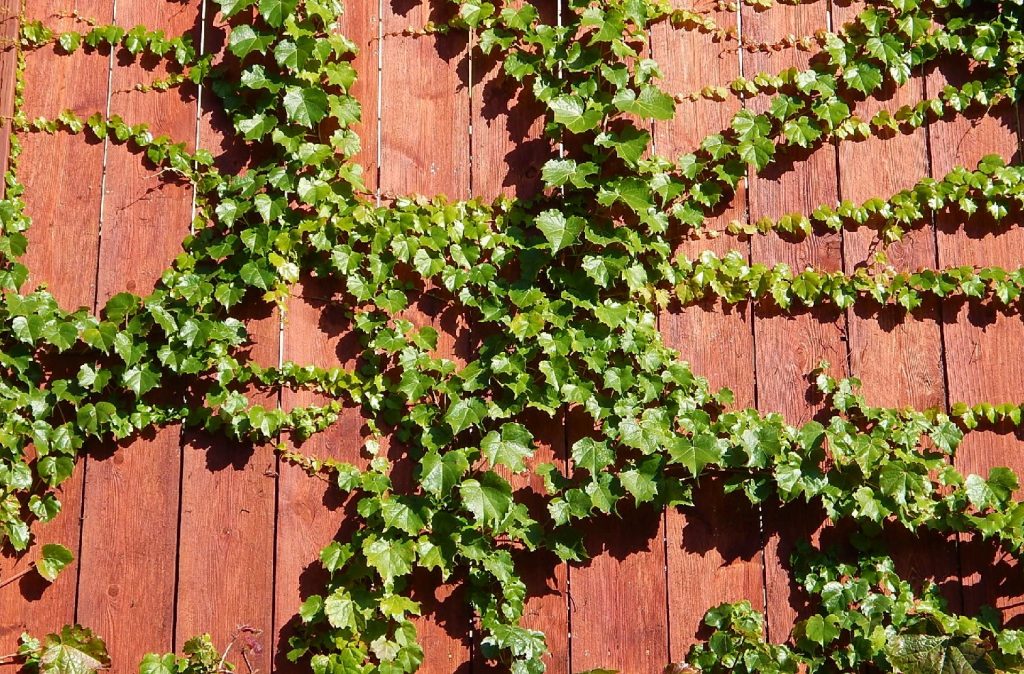
Star Jasmine (zones 8 through 10)
This fast-growing fence climber has a lot of points in its favor. For starters, it’s easy to grow. You don’t have to have a green thumb to get Star Jasmine to thrive. Second, it blooms from spring to summer, with long-lasting flowers that attract bees, butterflies, and hummingbirds. And third, this plant is very heat-tolerant, making it an excellent option for those who live in warm climates.
Star Jasmine needs full to partial sunlight to grow. It performs best when planted in loamy, slightly acidic soil, although it can grow in sandy and clay-rich soils, too. Star Jasmine’s honey-sweet scent makes it a welcome addition to any fenceline.
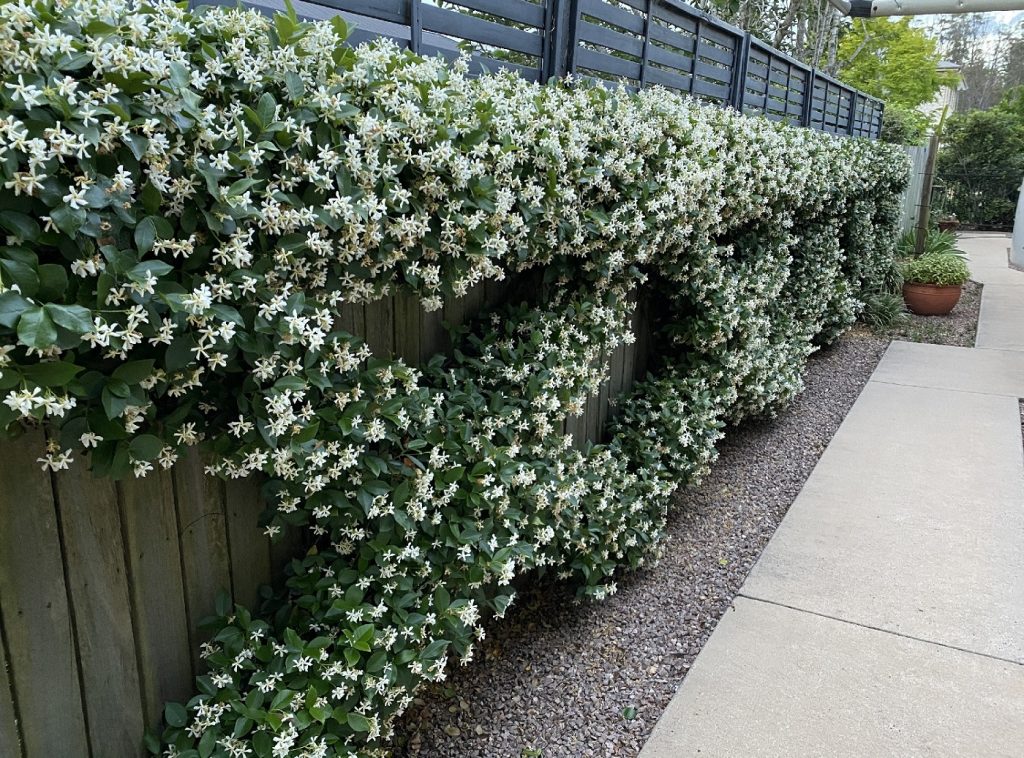
Passion Fruit Vine (zones 9 through 11)
There aren’t many plants that can truly thrive in full sun in the Southern portion of the U.S., but Passion Fruit Vine is one of them. This robust grower produces intricate purple flowers that are especially popular with insects. And, once pollinated, the flowers give way to small plum-colored fruits that make a deliciously tart treat on a warm summer’s day.
Passion Fruit Vine spreads roughly 10 feet wide and can grow up to 30 feet tall. This vine will grow in just about any soil, as long as it drains well. It does require regular waterings, though, and since it tends to smother surrounding plants, it may need to be trimmed back every so often to keep it in check. Grow your Passion Fruit Vines in full to partial sun to keep them healthy.
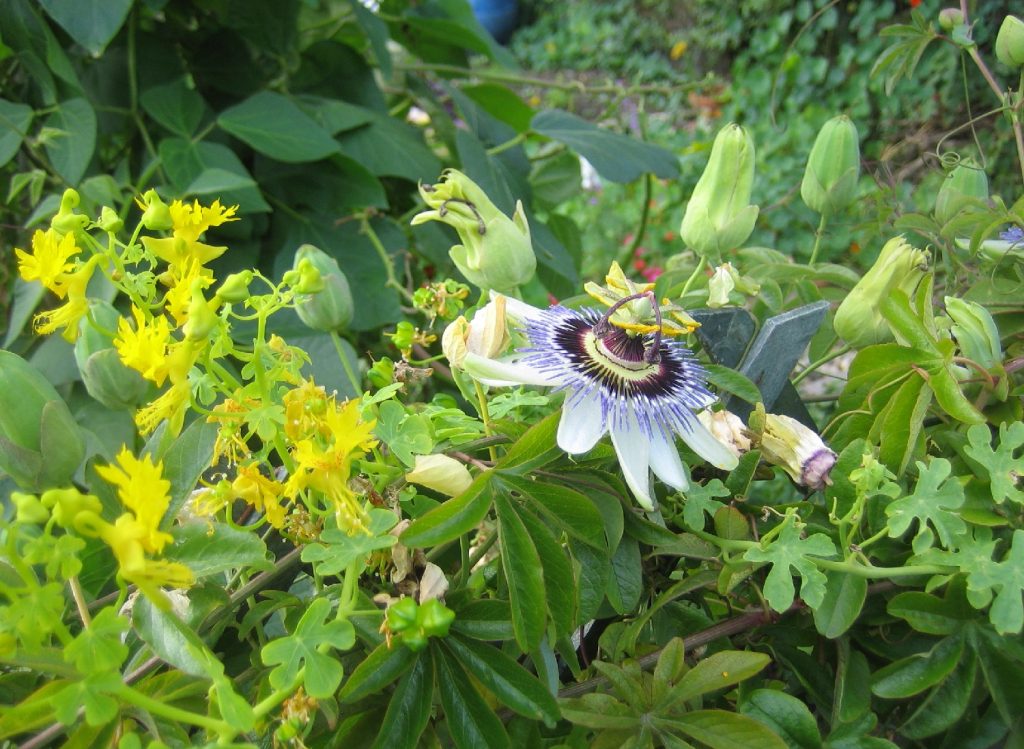
Climbing Roses (zones 5 through 10)
How big Climbing Rose plants get depends on their variety. But they average around 15 feet high, with a 6-foot spread. Climbing Roses prefer well-drained soil and can be planted in full sun — although, if you live in a hot climate, your Climbing Roses may need some afternoon shade. These plants are fairly drought-tolerant once established, but they do need to be watered weekly, or bi-weekly if they start to wilt.
Climbing Roses come in a variety of colors. ‘Joseph’s Coat’ produces roses in shades of brilliant pink and sunset yellow. ‘Don Juan’ Climbing Roses have classic red blooms and a strong rosy scent. Climbing Roses respond very well to winter pruning. Aggressive trimming in late fall to late winter drastically improves performance during the next growing season.
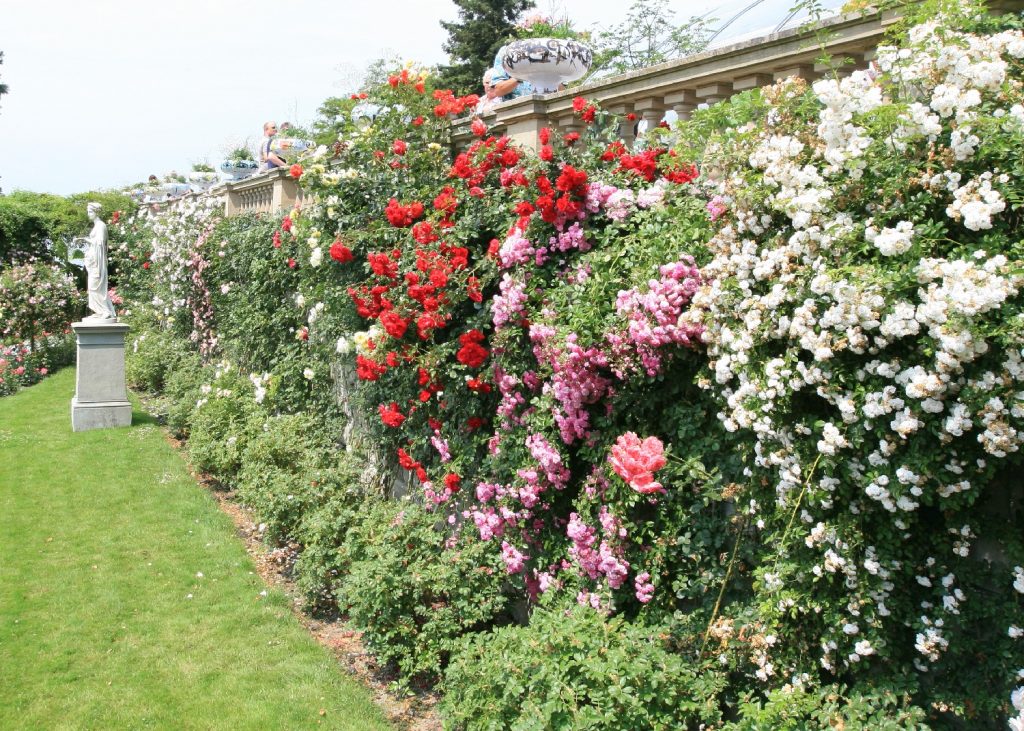
Morning Glory (zones 4 through 11)
You can find this flowering, fast-growing plant growing wild on roadsides and in parks across the United States. Morning Glory comes in different shades of pink, purple, red, blue, yellow, and white, with flowers erupting from the vines in mid-spring and new blooms budding out well into fall. As its name suggests, the Morning Glory’s flowers open in the morning hours, allowing hungry hummingbirds to collect their nectar. And, as the sun gets higher in the sky, the blooms close back up.
Morning Glory can grow quickly when cared for properly. This vine needs to be planted in well-drained soil in a spot that receives full to partial sunlight. At its biggest, Morning Glory reaches 10 feet tall and 6 feet wide. These plants die back every year during the winter, but if you allow them to go to seed first, they’ll reemerge on their own in the spring.
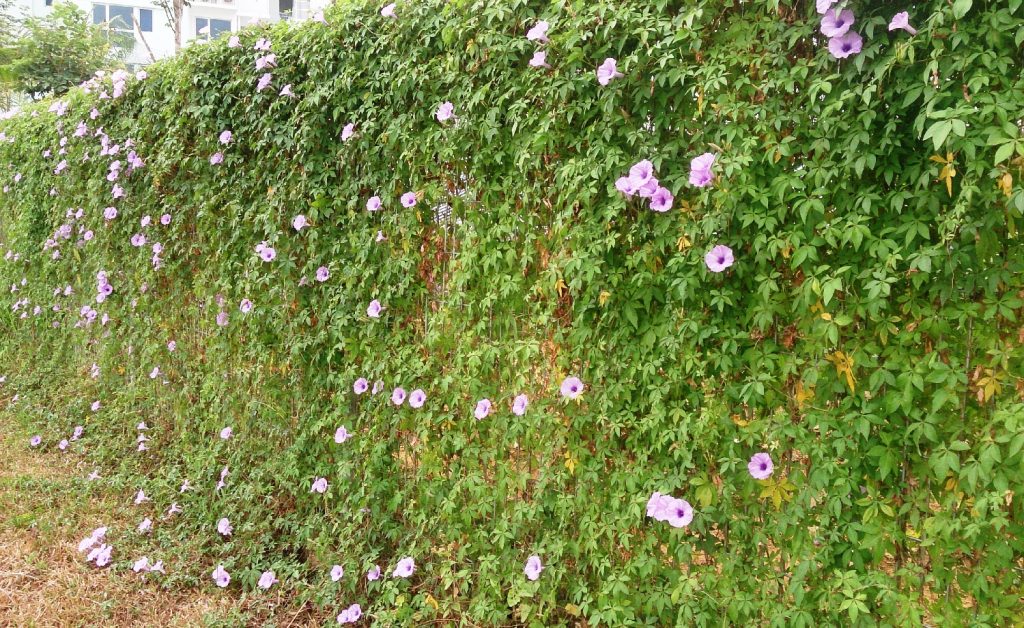
Bougainvillea (zones 9 through 11)
Traditionally, this showy flowering vine produces blooms in vivid shades of pink, purple, and red. But you can also find yellow and white varieties at some nurseries. Bougainvillea grows best in warm regions, where the mercury rarely dips below freezing. In these places, Bougainvillea can be grown as an evergreen.
Plant your Bougainvillea in full sun to optimize growth. Keep them in well-drained soil, and water them regularly in their first year to help them develop strong roots. Once established, these plants save on labor because they’re extremely drought-tolerant. Mature Bougainvilleas average 10 feet tall by 13 feet wide, but older plants can grow up to 40 feet long if cared for properly. Growing Bougainvillea against a fence allows the plant to take on a weeping shrub-like appearance as it ages, making it a mesmerizing focal point for your landscape.
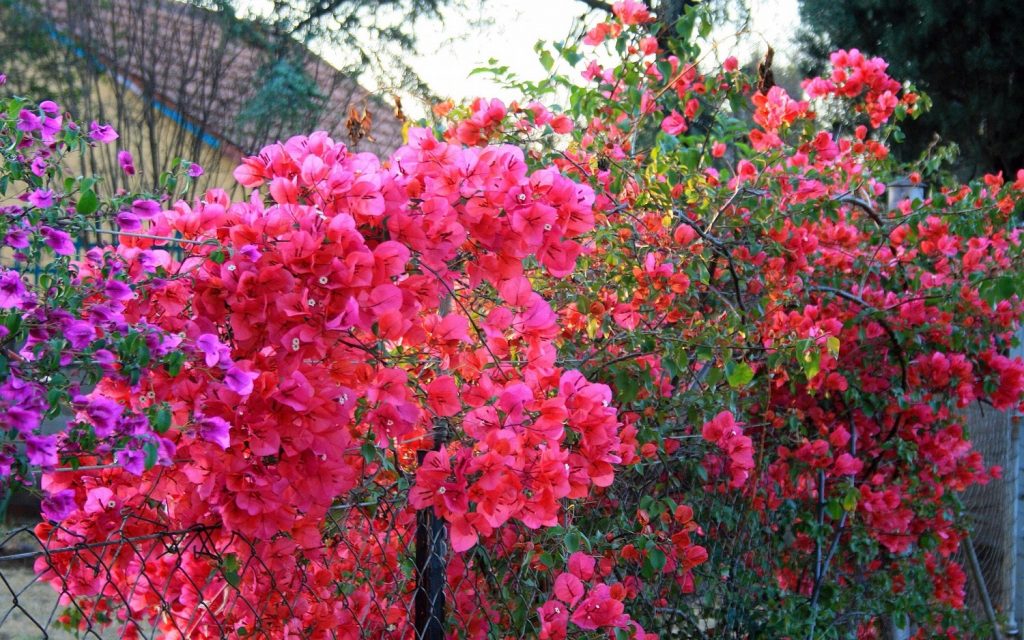
Muscadine Grapes (zones 7 through 9)
Muscadine Grapes grow like crazy when left to their own devices. Plant these vines in full sun and sandy, well-drained soil for best results. It’s important to water your Muscadine Grape plants every week during their first year. But after that, they’ll seldom need watering. Your region’s rainfall will likely be enough to keep these climbers satisfied.
Muscadine Grapes can grow up to 60 feet tall. In the wild, these vines have been known to smother full-grown oak trees, so you may want to keep them trimmed back. Harvest time for these grapes is in the fall. You can leave the grapes for deer, squirrels, and birds to dine on. But because they’re tasty and full of antioxidants, Muscadine grapes can be harvested to make fantastic homemade wines, jams, and jellies.
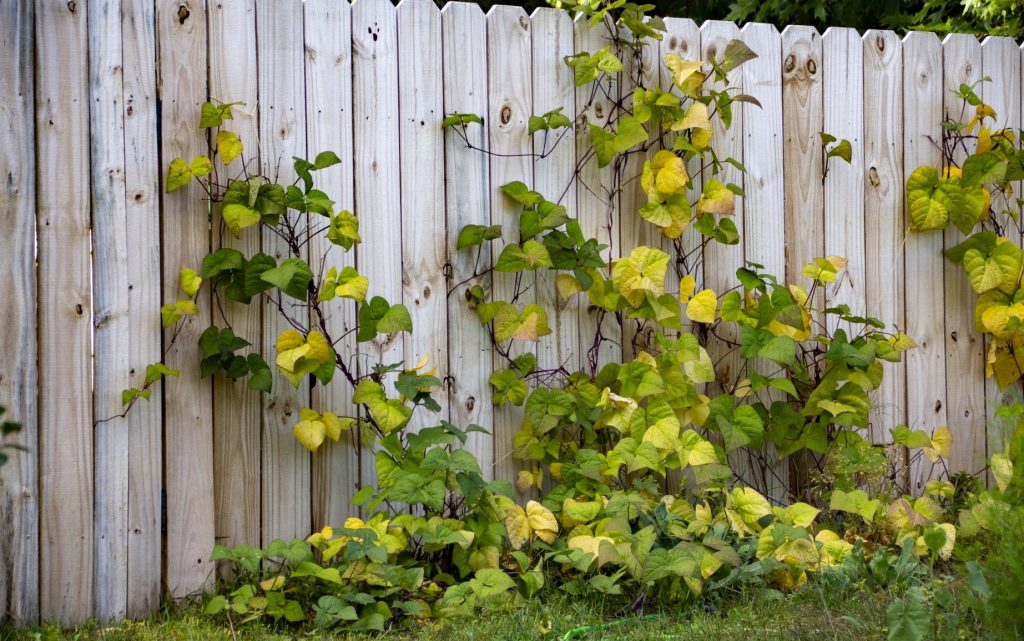
Caring for your fast-growing climbing plants
Whichever vining plant you choose, be sure to fulfill that plant’s specific growing requirements. This is critical for the plant’s health. If you don’t have time to worry about pruning, choose Trumpet Vine, Honeysuckle, and Star Jasmine, which look best when left unkempt. If you want something a bit more manicured, opt for Climbing Roses or Climbing Hydrangeas instead.
These 13 fast-growing climbing plants can turn your rundown fence sections into landscaping masterpieces. After a little labor upfront, you can enjoy years of spectacular blooms and foliage on your once-drab fences.
